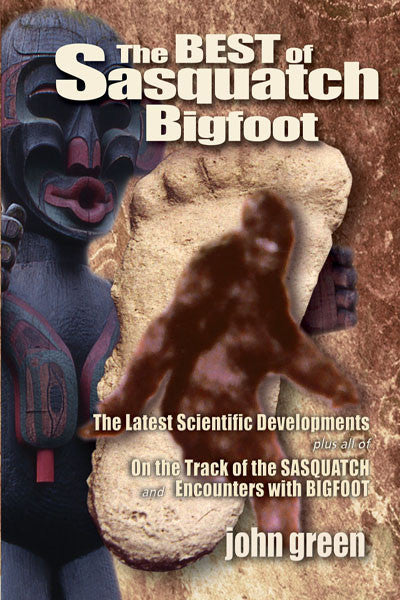

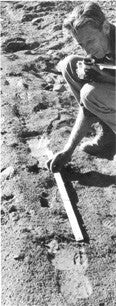
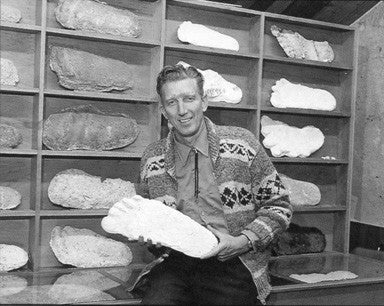
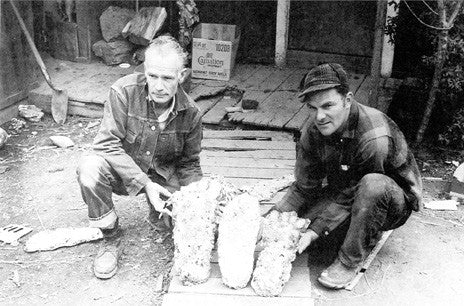
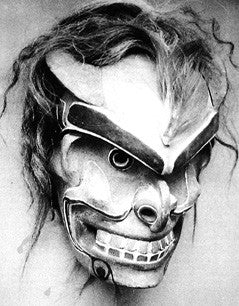
Best of Sasquatch Bigfoot
Details
By: Green, John
ISBN: 0-88839-546-9
Binding: Trade Paper
Size: 11" X 8.5"
Pages: 144
Photos: 120
Illustrations: 22
Publication Date: 2004
Description
PHOTO Highlights: Over 150 b/w photos, line drawings & maps
Description: Combined works of John Green's two best selling titles On the Track of the Sasquatch and Encounters with Bigfoot. Includes New material surrounding the recent controversies of the claims of fraud by Ray Wallace and others. The Best of Sasquatch Bigfoot combines legendary Sasquatch Researcher John Green's two best selling titles On the Track of the Sasquatch and Encounters with Bigfoot. This 144 page title includes all the original photos and information of his original titles, with an additional 16 pages of new material surrounding the recent controversies of the claims of fraud by Ray Wallace and others. John Green is the pre-eminent authority on the fascinating question of whether mankind shares North America with another upright-walking primate, having researched the subject for more than 40 years and assembled a file of more than 4,000 reports. Having been a newspaperman of more than 30 years experience, he is uniquely qualified to be the chronicler of the investigation as well as one of the leading participants. His previous books have sold close to 200,000 copies.
Author Biography
JOHN GREEN is a retired newspaperman. A graduate of both the University of British Columbia and Columbia University, he became interested in the sasquatch in 1957 while he was owner/publisher of the Agassiz-Harrison Advance newspaper and has spent the past 38 years as one of the most active participants in all aspects of the sasquatch investigation. His personal odyssey has ranged from hunting the sasquatch in the wild to following their trail across the continent, to tracking them by computer, and he has been the leader in the long attempt, only now beginning to bearing fruit, to involve the scientific community in the search.. He has written several books on the sasquatch and is considered a pre-eminent authority in the field, having been keynote speaker at all three of the major scientific symposiums so far held on this subject. John and his wife, June, live in Harrison Hot Springs, British Columbia. A profile of John's sasquatch-related activities is included in Meet the Sasquatch under Tributes - Canadian and American Researchers.
Book Reviews
Fate Magazine
December 2004
reviewed by Daniel Perez
Veteran Bigfoot author and researcher, John Green, from Harrison Hot Springs, British Columbia is out with his latest offering, The Best Of Sasquatch Bigfoot, which is essentially a compilation of two of his earlier works, On The Track Of The Sasquatch and Encounters With Bigfoot. The format of the book is 8.5 inches by 11 inches. Mr. Green's keen ability to write clearly and the illustrations and pictures make this book easy to pick up and digest. The handsome cover of this tome proclaims, The latest scientific developments, and what is new this time around is four chapters: 1.The Ape And the IM [Intermembral Index] Index, 2.Recent Developments, 3.Big Foot Did Not Die, and 4.$100,000 Reward. In his opening chapter Mr. Green states, Proof that a bipedal ape shares this continent with humanity is apparently considered so a big a story that it can't possibly be true. The headlines now are reserved for stories of the opposite kind, claims of proof that the Bigfoot tracks and the [1967] movie were just fakes after all. For those who have casually followed the Sasquatch story throughout the years without a body every being collected, news of fake tracks or whatever the case may be is usually reinforcement the whole Sasquatch story is bogus. For those who have intently watched the Sasquatch saga unfold over the years, it is clear there is a genuine mystery afoot. In chapter 1, The Ape And The IM Index, John Green addresses a recent claim that the famous subject, Patty, in the famous Patterson-Gimlin 16-millimeter film, was just a masquerade, nothing more than a man in a gorilla costume. He does well in clearing up all the recent nonsense about the issue but deliberately avoids (so as not to give them further publicity) specifics about the book in question and the man in the gorilla costume. Green's vagueness is very specific: ...a book was published in which the author claimed to have found the man who wore the ape suit... when I think he would have been better off with completeness: Greg Long penned the dross, The Making Of Bigfoot, in which he contends a one Bob Heironimus was the man in the suit in the P-G film. The IM Index, in its most generalized terms is the ratio or relationship between the length of the legs and arms and is used in discussion about primates. For instance, gorillas have an index in the order of 117; the average Joe, like you and me, that number is roughly 70. The IM Index for the subject in the P-G film, using sophisticated forensic animation software to measure the arms and legs, is between 85 and 90, clearly unlike the gorillas and by the same token unlike man as well. It is this powerful argument, using a scientific tool, the IM Index, that Mr. Green uses, and very effectively I might add, to absolutely demolish the notion the P-G film just portrays a costumed man. It is true that many who have dabbled in the Sasquatch studies have toyed with the numbers...length of leg, arm, etc., but Green alone takes credit for making the case for the Sasquatch with the IM Index. The Bigfoot body casting, collected in the Summer of 2000 in Washington state is discussed in a very positive manner yet skeptics within and outside the ranks of Bigfooters questioned the finding. What is absolutely factual about the Bigfoot body casting is it lends itself to many possible explanations, from elk to other known animals to complete fabrication. Opinions vary about the casting and Dr. Daris Swindler, a retired anthropologist, stated without reservation, in my opinion the impression is not made by a deer, a bear or an elk nor was it made artificially. The Skookum body cast is that of an unknown hominoid primate. However, the late Dr. Grover Krantz, another anthropologist, who was not sure what the Skookum cast represented, is not quoted at all. As a longtime reviewer and critic of the Sasquatch studies, one is left to wonder: Rick Noll [one of the finders of the Skookum impression]...had with him a couple of hundred pounds of exceptionally strong plaster. Who carries hundreds of pounds of plaster? Any skeptic might rightly question the convenience of having so much plaster on hand. At the end of 2002 Ray Wallace from Toledo, Washington died and the mainstream media put out a story essentially saying that Ray Wallace was the creator of Bigfoot, having laid many fake Bigfoot tracks in northern California with his strap on wooden feet. Here, what you have to understand the mainstream media of today is not like the media from a long time ago. Today, media is concerned with sensational stories that bring viewers and ratings. Ratings, in turn, is the engine which drives paying advertisers and it would seem that is their number one concern. Author Green absolutely dismantles Ray Wallace and his foolish claims and Mr. Wallace, in his own words: I have talked to the Big Foots many times they didn't understand me and I didn't understand them, further diminishes his own credibility. Further to the Ray Wallace fiasco, Green would write, demonstrations were put on for both CNN and FOX News in which their own people, walking on fiberglass copies of genuine 15 tracks, learned that deep tracks can't be made in firm sand that way, even, in the case of CNN, by two men weighing a combined 440 pounds. Of course, CNN didn't carry that non-story, instead the story was Sasquatch researchers refused to recognize the reality of the Wallace claims. So much for an unbiased press. We are indebted to have someone like John Green to be writing on the Bigfoot topic with clarity, depth, not to mention longevity. In 1961, forty-three years ago (!) the late Ivan Sanderson wrote about a much younger Green with, this priceless document was unearthed by the indefatigable John Green of the Agassiz-Harrison Advance... Also new to this book is the $100,000 dollar reward for anyone who can demonstrate how the 'Bigfoot' tracks that were observed in the Bluff Creek valley in northern California in 1958 and later could have been made by a human or humans. To date no one has managed to collect the reward. In closing, this work by John Green is a nice stroll down memory lane, with the classics revisited, like Albert Ostman's alleged abduction and Fred Beck's attack by Sasquatches in Ape Canyon. Mr. Green has always been big on coupling the Sasquatch with science, and rightly so. It is a serious topic and one with tremendous importance and possibly unbelievable implications, worthy of more than just tabloid fodder. However, the unemotional Green fails to cover the people aspect, the human side of the Sasquatch hunt. He could have, for instance, written quite extensively about his late friend, Bigfoot hunter Bob Titmus, who lived for many years just walking distance from Green's residence. And of his up but mostly down relationship with possibly the most famous Bigfooter of all time, the late Rene Dahinden. Readers want to know what Titmus was like and the same for Dahinden. Oh well, perhaps another book, another author. For now, however, John Willison Green, author of many works on the Sasquatch studies, has certainly cemented his place in history for having the willingness to go forward no matter what the cost.
Southeast Sasquatch Association blog
http://southeastsasquatchassociation.blogspot.com
Review by Henry May
July 29 2008
I received this book yesterday (September 14th, 2004) . I have read the books that are compiled in this collection before (On The Track Of The Sasquatch and Encounters With Bigfoot, also known as Year Of The Sasquatch), but there is new material in the first four chapters of the book. The first chapter, The Ape and The IM Index, examines the various ways that people have tried to debunk the Patterson/Gimlin film (without success, of course), as well as the Intermembral Index which determines how long the arms are in proportion to the legs. In humans, it's 70, while in the P/G film creature, it's in the high-80's, which makes it impossible to be a human in a costume. The second chapter, Recent Developments, discusses some of the prominent scientists who have come forward in defense of the Sasquatch, such as the late Dr. Grover Krantz, the late Dr. Leroy Fish, Dr. Jeff Meldrum, Dr. Jane Goodall, Dr. Russell Mittermier and several other luminaries. The Skookum Cast is also examined, as are the dermal ridge footprints examined by Jimmy Chilcutt.Chapter 3 focuses on the media attention which surrounded the death of Ray Wallace in late-2002, and the chapter is appropriately called, Bigfoot Did Not Die. The final chapter is called 100,000 Reward, which is a real reward given to anyone who can successfully duplicate the tracks found in and around Bluff Creek, California. The first four chapters are an excellent setup for the rest of the book, which is wonderfully written and researched. Get this book if you can.